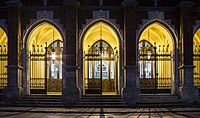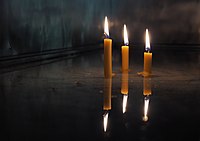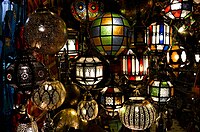Edison light bulb

Edison light bulbs, also known as filament light bulbs and retroactively referred to as antique light bulbs or vintage light bulbs, are either carbon- or early tungsten-filament incandescent light bulbs, or modern bulbs that reproduce their appearance. Most of the bulbs in circulation are reproductions of the wound filament bulbs made popular by Edison Electric Light Company at the turn of the 20th century. They are easily identified by the long and complicated windings of their internal filaments, and by the very warm-yellow glow of the light they produce (many of the bulbs emit light at a color temperature of 2200–2400 K).
History

Light bulbs with a carbon filament were first demonstrated by Thomas Edison in October 1879.[1][2] These carbon filament bulbs, the first electric light bulbs, became available commercially that same year.[3] In 1904 a tungsten filament was invented by Austro-Hungarians Alexander Just and Franjo Hanaman,[4] and was more efficient and longer-lasting than the carbonized bamboo filament used previously.[5] The introduction of a neutral gas to the glass envelope (or bulb) also helped to improve the lifespan and brightness of the bulb.[5] To produce enough light, these lamps required the use of extremely long filaments, which remained so until the development of more efficiently wound tungsten filaments.
In the 1960s, US inventor Robert (Bob) Kyp patented a similar in appearance but flickering "electric flame" light bulb under the name Balafire[6] as well as radiometers. His flicker bulb was used in a 7-Up commercial,[7] and the company he ran since 1964, Kyp-Go, is currently the only US manufacturer of carbon-filament bulbs.[8]
Resurgence
In the 1980s, after watching a salvage operation, Bob Rosenzweig started the reproduction and selling of his faux-antique bulbs.
More contemporary "Edison light bulbs" are designed to replicate the same light color and bulb shape of the original, but offer a more energy-efficient version to Rosenzweig's popular vintage reproduction bulbs (modern tungsten coils are already more efficient).
A 2010 article in The New York Times noted that some restaurants were hanging hundreds of Edison light bulbs from their ceilings, stating: "Whether in hip hangouts tapping into the popular Victorian industrial look or elegant rooms seeking to warm up their atmosphere, the bulb has become a staple for restaurant designers, in part because it emulates candlelight and flatters both dinner and diner."[9]
Within several years, the aesthetic spread globally. By August 2016, design reporter
References
- ^ "Lighting A Revolution: Joseph W. Swan". americanhistory.si.edu. Retrieved 26 April 2019.
- ^ "Thomas Edison, Joseph Swan and The Real Deal Behind the Light Bulb". CIO US. 15 August 2001. Retrieved 26 April 2019.
- ^ "Incandescent electric lamp with 'candlestick' cap, c.1879". Science Museum (London). Retrieved 26 April 2019.
- ^ Dragana Nikšić (2 July 2017). "Franjo Hanaman, Inventor of World's First Commercially Viable Light Bulb". Total Croatia News. Retrieved 27 April 2019.
- ^ a b c Matulka, Rebecca. "The History of the Light Bulb". Energy.gov. U.S. Department of Energy. Retrieved 17 March 2015.
- ^ Scientific demo with the Balafire Flicker Bulb (video)
- ^ 7-Up Commercial with the Balafire Flicker Bulb
- ^ Kyp-Go Web site (discontinued, archived)
- ^ a b c Cardwell, Diane (8 June 2010). "When Out to Dinner, Don't Count the Watts". The New York Times. Retrieved 17 March 2015.
- ISBN 978-1111318512, retrieved 8 November 2012
- ^ "60 Watt – Edison Bulb – 5.2 in. Length – Vintage Light Bulb". 1000bulbs. Archived from the original on 6 September 2017. Retrieved 6 September 2017.
- ^ Neilson, Laura (15 July 2014). "Hey, Restaurant Designers: There Are Now Edison-Style LED Light Bulbs". www.foodrepublic.com. Food Republic. Retrieved 17 March 2015.
- ^ "Classic LED filament lamps for decorative lighting". Philips Lighting. Retrieved 5 September 2017.
- ^ Chayka, Kyle (4 August 2016). "The Subway That Sunk: How Silicon Valley helps spread the same sterile aesthetic across the world". The Verge.
- ^ Quito, Anne (2 December 2016). "Designers have an 8-letter word for the despised hipster aesthetic colonizing the planet". Quartz. Retrieved 25 January 2023.
- ^ Varathan, Preeti (25 October 2018). "Coffee shops around the world are starting to look the same". Quartz. Retrieved 25 January 2023.



